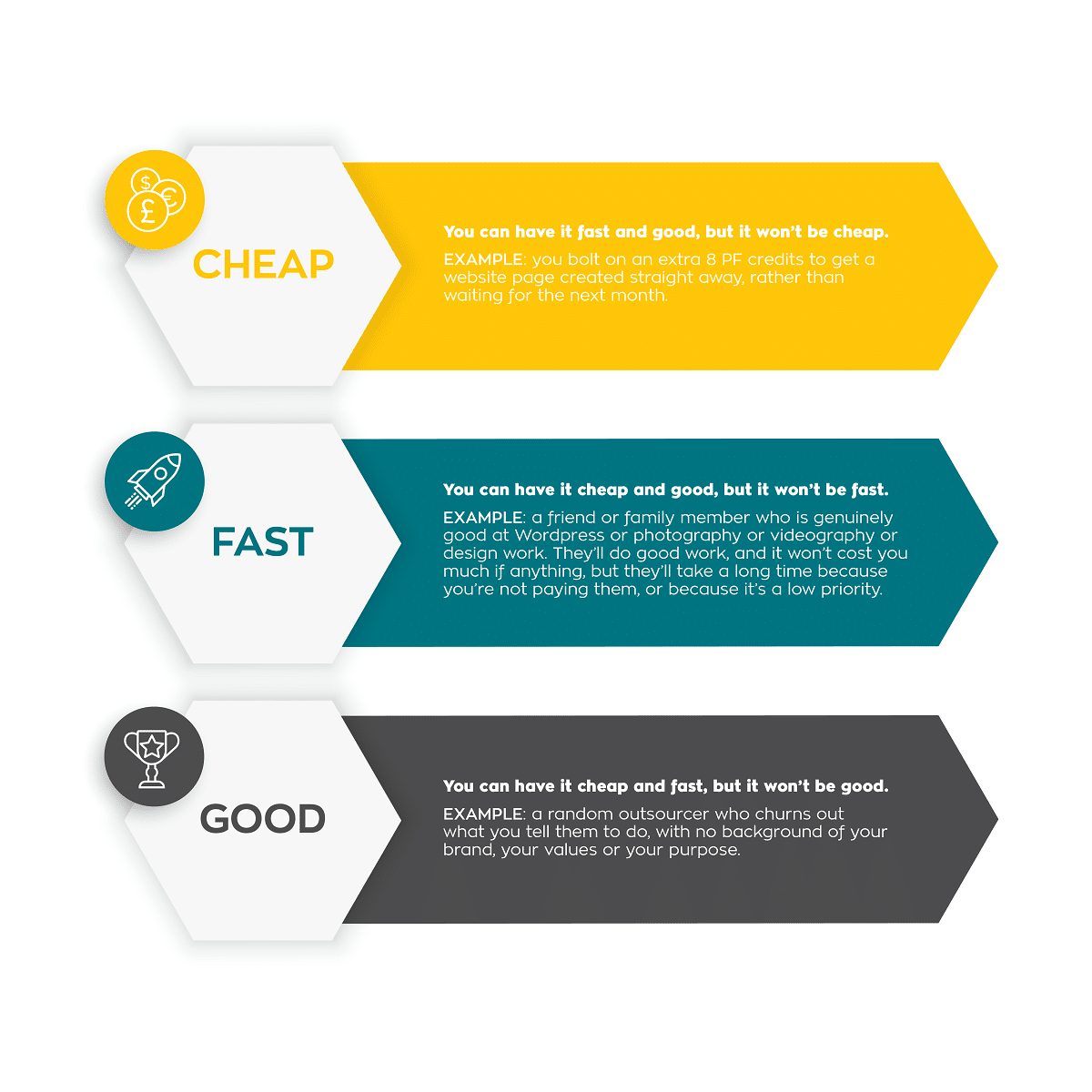
As a percentage of sales, work towards the goal of your marketing spend being 3-10 percent of your firm’s annual sales, every year.
Whether you have a large or small firm, that number can feel “too big” at first, when you consider it purely in terms of the pounds or dollars you’re investing. And if you’re starting from having spent close to zero percent, or at best 1%, in the past, it’s a big jump to increase it.
To help consider how marketing works, think about it like a steam engine. A steam engine uses a coal fire as its source of energy, to boil water and make steam. This steam gathers, and the engineer regulates the amount of steam being sent to the pistons, which connect to the wheels, which move the train forward.
Once you’re going, you can really pick up speed. Apparently steam engines can go as fast as 126 miles per hour; usual cruising speed may be closer to 40 or 50 mph.
If you’re just getting started with marketing, you’ve essentially got a cold train. The fuel of your marketing is there: your firm, brand, website, work you’ve done in the past, kind words from clients. You might have a very small pile of “coal”.
But none of it is being used – or very little. Time to use that fuel, and get your train started.
Getting your marketing to move fast – really fast, like hitting that world record of 126 mph – requires a good build up of steam. You’re not going to do that from a standing start.
It’s going to take a bigger investment – of time, and money – at the beginning to build up that head of steam and get the train really moving. You’ll need to invest in more coal, or marketing fuel: write blog posts, record videos, get images designed, create new website pages and helpful resources. You’ll need to get those pistons going: post regularly on social, publish videos, embed into your website, send emails. You might need to invest a higher percentage – maybe closer to the 8 or 10% – in the early days when you need to invest in foundational elements like a new brand or a custom-built website.
Once you’ve got those, your percentage will vary depending on what you do in-house and what you outsource. You may even decide to build an internal marketing team. The firms we work with who have followed the marketing map, created content consistently for at least three years, and are in that dream place of getting a drip feed of leads and clients they want will have a marketing spend within the 5–8 percent range, and some spend more. Other firms, once they’ve invested in their foundations, are down nearer the 2-3% range because they spent bigger money in the early days, and now they’re simply keeping their steam engine chugging away.
Where does your marketing spend sticker shock come from?
When you’re considering your marketing spend, it’s all about value. In the same way your potential clients might get a shock at the idea of spending hundreds (or even thousands) a month with a “proper” accountant (after they’ve been trying to wrangle everything themselves), you also might feel like a big marketing spend is “too much”. And just like your potential clients, it all comes down to the value you receive, and how that’s perceived.
As you consider the 3-10% number for your firm, think about your business model. Consider the average length of time a client stays with your firm, and the value of investing in one really good client you and the team love and who is profitable to you. Many buyers of accounting firm services remain with their accountant on average between 10 and 17 years. So yes, you make the investment early on, but take your average client fee and multiply it by 10 or even 17 years, and you’ll see how much one new client is really worth to you. If on average your clients are spending say £600/month, at the higher end that one new client you won could be worth over £10k to the firm. The higher the average and the longer the time your clients remain with the firm, the more each client is worth.
If your proposed marketing spend seems far beyond what you were considering, there are questions you can ask yourself about that sticker shock. Often when we say something isn’t in our budget, what we really mean is “I don’t understand how it will be worth that and how it will pay itself back” or “I didn’t have a budget in mind, but that feels high.” When this happens, think about where your sticker shock is coming from:
- An experience you’ve had in the past: You could be comparing the quote you got for a marketing service to another kind of service altogether. Maybe you always used templates for building websites, and it’s new to consider a custom-built site based on your clients’ journey, and your budget number relates to that other kind of service.
- Different types of approaches by marketing companies: A quote from a freelancer building a website for you in their free time is going to massively differ from a quote received from a marketing agency involving content writers, designers, developers, and an entire team.
- Length of time since you last got a proper quote: The number in your head might be two, five, or twenty years old. It’s now years later, and prices have changed.
Foundational marketing projects can feel more expensive. This kind of project sets the tone for other marketing which will stack on top of it, beyond the item itself. Branding and websites fall within this category; it’s really hard (if not impossible) to track the full return on the amount you spend on a good brand for your accounting firm or on a custom-built website.
Remember, especially with the larger foundational projects, it’s not really a “one-to-one” return you’re looking at. “We spent £10k on a new website and the next week we got a new client who is spending £10k/year”. That might happen: but it also might be a combination of marketing elements coming together.
Just as your prospective clients need to understand the value they’ll receive from what you quote them, so too you need to know what your marketing spend is doing for you.
If you say you want a new website, but when you get the quote it feels too high, you might not be seeing the connection of this project to every other part of marketing: your brand, your hiring, your prequalifying, your onboarding. It can end up being a grudge buy. It’s just a box to tick, so the value will never be much higher than the vague number in your head.
Another helpful principle to consider is that of stackable content. One piece of content, one designed item, or even a new full rebrand does not exist in a silo. It forms yet another part of your entire marketing message, repeated over and over, day after day, in both small and great ways. A project you consider “small”, like getting an asset or a website page designed, can seem expensive at the start. But you’re investing in another part of your whole marketing picture, that one spend begins to take on more value. Read more about stackable content here.
Even a small project is an investment, stacking together so your prospects get a picture over time. Good marketing means you’re in it for the long term – not necessarily getting an instant return on your one marketing item, but contributing another high-quality marketing item to your firm’s story.
The good-cheap-fast rule: you can only have 2 out of 3
You’ll likely be familiar with the good-fast-cheap rule. When it comes to the three qualities of good, fast, and cheap, you may only ever have two out of three at the most, and this absolutely applies to marketing.

When marketing is good and fast, it won’t be cheap. If it’s fast and cheap, it likely won’t be good. And sometimes with the very best marketing, you only get one.
Good only (not cheap or fast): The complete rebrand. You have got to be all in with this kind of project, willing to dig deep and go slow if you need to. A branding project needs creative space, and rest, and time to think. Better done right than rushed.
Fast only (not good or cheap): You find someone who throws together a website for you in a week or a month. You thought they knew what they were doing, but there were a lot of things they missed, and it ended up costing you about ten times more than you planned in the long run. As the saying goes, if you think hiring a professional is expensive, try hiring an amateur.
Cheap only (not good or fast): You “just want” whatever it is—a graphic designed, some video editing, or a new website page built. You hire a freelancer you’ve never heard of because you’re not sure how to value it, and you don’t think it’s that important. Not only do they do a sort of okay job at best, it takes way longer than you planned, and all that money you saved doesn’t do you much good when you end up waiting months for it because they got busy or never replied to your messages asking about the status.
Where does your marketing budget come from?
Sometimes when you’re asked, “What is your marketing budget?”, it’s hard to answer because you aren’t sure yet. You don’t know what you don’t know. And I also know what it feels like not to want to throw out a number in case the company latches onto it.
You know the feeling when you request a quote from a company and they ask, “What is your budget for this?” You have an instant fear reaction, thinking, “I know why they’re asking this. They want to know the number in my head so they can meet it or go a little above or below it. If I say £10,000, they’ll give me a quote for £9,995. They’re just trying to get as much money as they can.”
Sadly, some businesses do work like that. It happened to me when I got a quote from an agency who asked my budget. I said I didn’t know because this was all new to me, but I had done enough research to know it would have to be in the £8 to £10K range. The quote came in at (I kid you not) £9,999. It felt suspicious, and it made it hard to truly value the quote and the service.
Your prospects feel this too. Some people who get a proposal from you have either had a bad experience with their former accountant or no experience at all. They don’t know what to expect or how much it’s supposed to cost or what they get for the money they spend. Even if you asked them what their budget was, it’s probably too low because they don’t understand where that money goes, and why, and what they get from it. The fees your clients need to spend on accounting will vary on their type of business, the state of their bookkeeping, their business model, and their understanding of the value you will help deliver as they work with you.
Having a continual relationship with a marketing agency matters for your marketing spend
Consistently working with the same agency and the same people who have known you since the rebrand or since the website build day in and day out, month in and month out, will help your marketing investment be more effective over time.
When we’ve been working with a firm for five years and they have a huge opportunity and need a PDF guide, or a slide deck, or social images created urgently, we know them and their firm so well we can move fast. We are already familiar with their brand, colours, style, tone, and team. We have all the brand files. We’ve got the PDF guides or slide decks we’ve created in the past with them and can adapt quickly based on the new information.
If you’re continually changing the people or agencies who help you with various kinds of marketing, you’re going to feel really frustrated (and so are they), especially if you’re using multiple people or agencies who aren’t talking to each other. It’s not cohesive. Everyone is sitting in their own little rooms, separate from each other, and no one is really talking to you and the team on a daily basis. You won’t get good marketing done, and you won’t see good results because it’s not collaborative and consistent.
Consider the cost of not doing this marketing right now
Finally, as you consider your marketing investment, ask yourself the cost of not doing this now. We’ve seen people get a new website page created, and the new page is put together so well with the right messaging and the right calls to action that people who are looking for that particular service sign up within minutes.
Think about how many people are coming to your website or your other marketing and saying “Ehhhh, I’ll decide later.” Does your marketing cause them to hesitate or to hurry up? If it causes them to hesitate, you’re losing business—and probably from the very best kind of clients, too. The kind you really like and really want and wish you had more of. Many of you have clients who are not living up to your values, and they’re frustrating and difficult, and the team grits their teeth a bit when they get in touch. You need to replace those clients. That’s a big cost. Think about what it’s costing you to wait.
Above all, collaboration is key. We want to see accountants use their marketing money well and get to work with the kind of clients you love. Whoever you work with, make sure you love working with them and respect their approach, their methodology, their values, and their people. All of those are part of the service you receive when you collaborate on your marketing. It is never as simple as paying someone some money and getting some money back. Like the conversations you have with your clients, this is relational, not merely transactional. Life is too valuable and too beautiful to simply trade money around.
Whatever the status of your marketing right now, start by joining the Accelerator coaching group with other accountants who feel like you do. There’s a small investment you make to start, and you have the option to go deeper, or add more, as you move forward. You might just take what you learn and apply it yourself. Either way, you’ll identify the status of your marketing’s “steam engine”, and how you can really get it going – so it picks up speed and brings you the kind of clients you love to work with!

